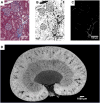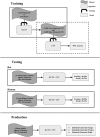Region-Based Convolutional Neural Nets for Localization of Glomeruli in Trichrome-Stained Whole Kidney Sections
- PMID: 29921718
- PMCID: PMC6065078
- DOI: 10.1681/ASN.2017111210
Region-Based Convolutional Neural Nets for Localization of Glomeruli in Trichrome-Stained Whole Kidney Sections
Abstract
Background Histologic examination of fixed renal tissue is widely used to assess morphology and the progression of disease. Commonly reported metrics include glomerular number and injury. However, characterization of renal histology is a time-consuming and user-dependent process. To accelerate and improve the process, we have developed a glomerular localization pipeline for trichrome-stained kidney sections using a machine learning image classification algorithm.Methods We prepared 4-μm slices of kidneys from rats of various genetic backgrounds that were subjected to different experimental protocols and mounted the slices on glass slides. All sections used in this analysis were trichrome stained and imaged in bright field at a minimum resolution of 0.92 μm per pixel. The training and test datasets for the algorithm comprised 74 and 13 whole renal sections, respectively, totaling over 28,000 glomeruli manually localized. Additionally, because this localizer will be ultimately used for automated assessment of glomerular injury, we assessed bias of the localizer for preferentially identifying healthy or damaged glomeruli.Results Localizer performance achieved an average precision and recall of 96.94% and 96.79%, respectively, on whole kidney sections without evidence of bias for or against glomerular injury or the need for manual preprocessing.Conclusions This study presents a novel and robust application of convolutional neural nets for the localization of glomeruli in healthy and damaged trichrome-stained whole-renal section mounts and lays the groundwork for automated glomerular injury scoring.
Keywords: Renal pathology; glomerular disease; glomerulus; kidney disease; renal injury; renal morphology.
Copyright © 2018 by the American Society of Nephrology.
Figures




Comment in
-
AI: What Have You Done for Us Lately?J Am Soc Nephrol. 2018 Aug;29(8):2031-2032. doi: 10.1681/ASN.2018050566. Epub 2018 Jun 19. J Am Soc Nephrol. 2018. PMID: 29921720 Free PMC article. No abstract available.
References
-
- Kakimoto T, Okada K, Hirohashi Y, Relator R, Kawai M, Iguchi T, et al. .: Automated image analysis of a glomerular injury marker desmin in spontaneously diabetic Torii rats treated with losartan. J Endocrinol 222: 43–51, 2014 - PubMed
-
- Bertram JF, Soosaipillai MC, Ricardo SD, Ryan GB: Total numbers of glomeruli and individual glomerular cell types in the normal rat kidney. Cell Tissue Res 270: 37–45, 1992 - PubMed
Publication types
MeSH terms
Substances
Grants and funding
LinkOut - more resources
Full Text Sources
Other Literature Sources
Medical
Molecular Biology Databases

